The below article on the History of Iranian-Georgian relations first appeared in the Encyclopedia Iranica in December 15, 2001 and was updated in that encyclopedia in February 7, 2012.
Kindly note that excepting one map, the version printed below has embedded photographs and captions used in Kaveh Farrokh’’s lectures at the University of British Columbia’s Continuing Studies Division, Stanford University’s WAIS 2006 Critical World Problems Conference Presentations on July 30-31, 2006, University of Southern California and the University of Yerevan (Iranian Studies Department); there are also pictures from Burusi website of Georgia.
==================================
Between the Achaemenid era and the beginning of the 19th century, Persia played a significant and at times decisive role in the history of the Georgian people. The Persian presence helped to shape political institutions, modified social structure and land holding, and enriched literature and culture. Persians also acted as a counterweight to other powerful forces in the region, notably the Romans (and Byzantines), the Ottoman Turks, and the Russians. (See map, Figure 2). But the Persian-Georgian relationship was by no means one-sided, for the Georgians contributed substantially to Persia’s military and administrative successes and even affected its social structure, especially under the Safavids.
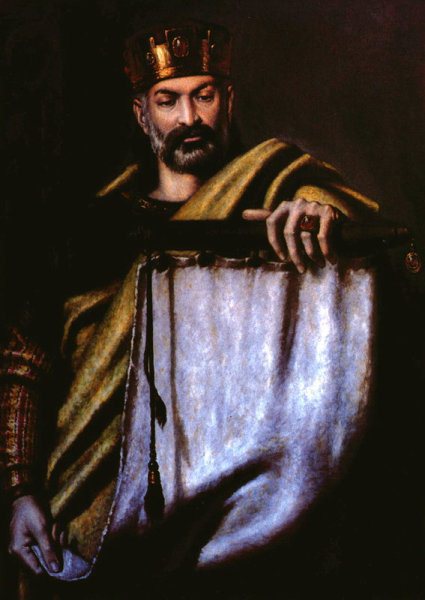 A Georgian portrayal of the legendary King Pharnavaz of Georgia who was the king of Karli in the 3rd century BCE. Kartli was identified as Iberia by the Classical sources (Source: Burusi). According to the Georgian Chronicles (royal annals, page of edition 25, line of edition 4): “…Pharnavaz made all and everything alike the Kingdom of the Persians” (as cited by ). It has been suggested that Pharnavaz based his adminstration upon an Iranian system (see Rapp, Stephen H., Studies In Medieval Georgian Historiography: Early Texts And Eurasian Contexts. Peeters Bvba, 2003, p.275).
A Georgian portrayal of the legendary King Pharnavaz of Georgia who was the king of Karli in the 3rd century BCE. Kartli was identified as Iberia by the Classical sources (Source: Burusi). According to the Georgian Chronicles (royal annals, page of edition 25, line of edition 4): “…Pharnavaz made all and everything alike the Kingdom of the Persians” (as cited by ). It has been suggested that Pharnavaz based his adminstration upon an Iranian system (see Rapp, Stephen H., Studies In Medieval Georgian Historiography: Early Texts And Eurasian Contexts. Peeters Bvba, 2003, p.275).
Information about relations between the Achaemenids and the inhabitants of present-day Georgia is fragmentary. During the Achaemenid domination of eastern Anatolia and Transcaucasia (546-331 B.C.E.) proto-Georgian tribes were, according to Herodotus (3.94), included in the 18th and 19th satrapies (T. Kaukhchishvili, ed., pp. 10-11). Although the territory of present-day southern Georgia fell within the Achaemenid state, the Achaemenids apparently never brought those tribes living further to the north under their control. When they tried to do so their aggressiveness led to the formation of large associations of northern proto-Georgian tribes (Melikishvili, pp. 235, 273). Xenophon was aware of the changed conditions in 401-400 B.C.E. when he noted in the Anabasis that these tribes, including those of Colchis (q.v.), had ceased to be under Achaemenid rule (Mikeladze, ed., pp. 13-14). By this time proto-Georgians were moving into the Kura valley, where, merging with indigenous tribes, they eventually formed the Georgian people (Lang, 1966, pp. 57, 75-76; on political formations in eastern Georgia, see Melikishvili, ed., pp. 422-44).
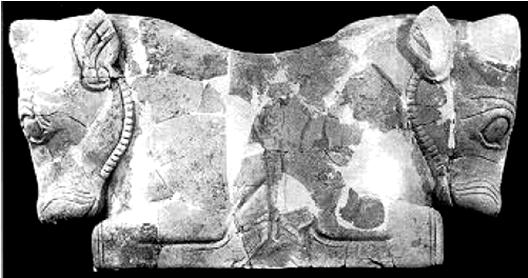 Ancient Georgian Column Capital discovered in Tsikha Gora (Courtesy of Gagoshidze and Kipiani). Note the striking resemblance to the column capital from Persepolis below (Picture and caption from Kaveh Farrokh’s lectures at the University of British Columbia’s Continuing Studies Division, Stanford University’s WAIS 2006 Critical World Problems Conference Presentations on July 30-31, 2006, University of Southern California and the University of Yerevan (Iranian Studies Department).
Ancient Georgian Column Capital discovered in Tsikha Gora (Courtesy of Gagoshidze and Kipiani). Note the striking resemblance to the column capital from Persepolis below (Picture and caption from Kaveh Farrokh’s lectures at the University of British Columbia’s Continuing Studies Division, Stanford University’s WAIS 2006 Critical World Problems Conference Presentations on July 30-31, 2006, University of Southern California and the University of Yerevan (Iranian Studies Department).
Alexander the Great’s victory over Darius III in 331 B.C.E. gave impetus to the formation and consolidation of an independent Georgian monarchy in the following two centuries (on political and ethnic questions between the 3rd and 1st centuries B.C.E., see Melikishvili, ed., pp. 445-67). The first king of Iberia, the ancient name for the territory of present-day Kartli (Kārtīl) and Kakheti (Kāḵet), or eastern Georgia, was the half-legendary Parnavaz (S. Kaukhchishvili, ed., I, pp. 4-10, 26), who took Persian institutions as models in organizing his realm. The example set by the Persian state system in eastern Georgia was undoubtedly a consequence of the earlier influence exercised by tribal formations in southern Georgia. Long controlled by the Achaemenids, they extended Persian influence northward, as their aristocracies expanded their own power base.
Between the 3rd and 7th centuries C.E. Iberia maintained a precarious existence between the two great rivals for control of the Caucasus, namely Persia and Rome (later Byzantium). Georgian kings successfully played one off against the other and thereby preserved their freedom of action. But as they came to rely on Rome to uphold strong monarchical institutions, they became estranged from the great nobles, who sought support from Persia to thwart the centralizing ambitions of their kings.
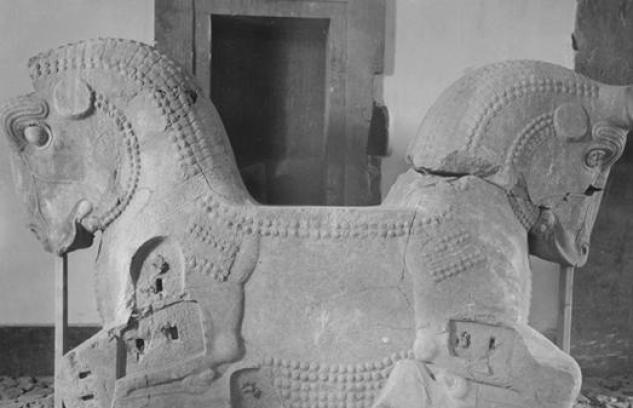 The double-bull motif column capital typical of Achaemenid-era architecture in sites such as Persepolis and Susa. Note the vivid parallels in style, construction and motifs to its Georgian counterpart shown further above. Architecture is only one of the many facets in which the ancient Caucasus and Persia have enjoyed mutual influences (Picture and caption from Kaveh Farrokh’s lectures at the University of British Columbia’s Continuing Studies Division, Stanford University’s WAIS 2006 Critical World Problems Conference Presentations on July 30-31, 2006, University of Southern California and the University of Yerevan (Iranian Studies Department).
The double-bull motif column capital typical of Achaemenid-era architecture in sites such as Persepolis and Susa. Note the vivid parallels in style, construction and motifs to its Georgian counterpart shown further above. Architecture is only one of the many facets in which the ancient Caucasus and Persia have enjoyed mutual influences (Picture and caption from Kaveh Farrokh’s lectures at the University of British Columbia’s Continuing Studies Division, Stanford University’s WAIS 2006 Critical World Problems Conference Presentations on July 30-31, 2006, University of Southern California and the University of Yerevan (Iranian Studies Department).
Decisive for the evolution of the Georgian state was the foundation of the Sasanian Empire in 224. By replacing the weak Parthian realm with a strong, centralized state, it changed the political orientation of Iberia away from Rome. Iberia apparently became a part of the Sasanian state during the reign of Šāpūr I (240-70), who in his famous inscription at Kaʿba-ye Zardošt (l.3) listed Iberia (Wiržān) as one of the lands that paid him tribute (Melikishvili, pp. 391-92). Relations between the two countries seem to have been friendly at first, as Iberia cooperated in Persian campaigns against Rome, and the Iberian ruler was a high dignitary of the Sasanian realm, not a vassal who had been subdued by force of arms (S. Kaukhchishvili, ed., I, p. 57). But the aggressive tendencies of the Sasanians were evident in their propagation of Zoroastrianism, which was probably established in Iberia between the 260s and 290s (Lukonin, p. 32).
In the contest for supremacy in the Caucasus, the advantage lay with Rome, whose armies defeated the Persians in a series of battles toward the end of the 3rd century. The Treaty of Nisibis in 298 assured Roman control of eastern Georgia (Kartli) for the next sixty years (Frye, pp. 130-31). Roman predominance proved crucial, since the Georgian king and leading nobles were converted to Christianity, probably in 330. By making Christianity the state religion, they erected what became an insurmountable barrier to Persian influence in the region.
In the 4th century the position of Iberia worsened, as its powerful neighbors became increasingly aggressive. Iberian kings chose Rome (Byzantium) as the least dangerous to their independence, but Persia became predominant after the defeat of the Roman armies before Ctesiphon in 363 (Frye, pp. 137-38). Rome ceded control of Kartli to Persia, and the king of Kartli, Varaz-Bakur II (363-65), became a Persian vassal, an outcome confirmed by the Peace of Acilisene in 387. Although a later ruler of Kartli, Pharsman IV (406-9), preserved his country’s autonomy and ceased to pay tribute to Persia (S. Kaukhchishvili, ed., I, p. 133), Persia prevailed, and Sasanian kings began to appoint a viceroy (pitiaxš/bidaxš) to keep watch on their vassal. They eventually made the office hereditary in the ruling house of Lower Kartli, thus inaugurating the Kartli pitiaxšat, which brought an extensive territory under its control. Although it remained a part of the kingdom of Kartli, its viceroys turned their domain into a center of Persian influence (Berdzenishvili et al, I, p. 109).
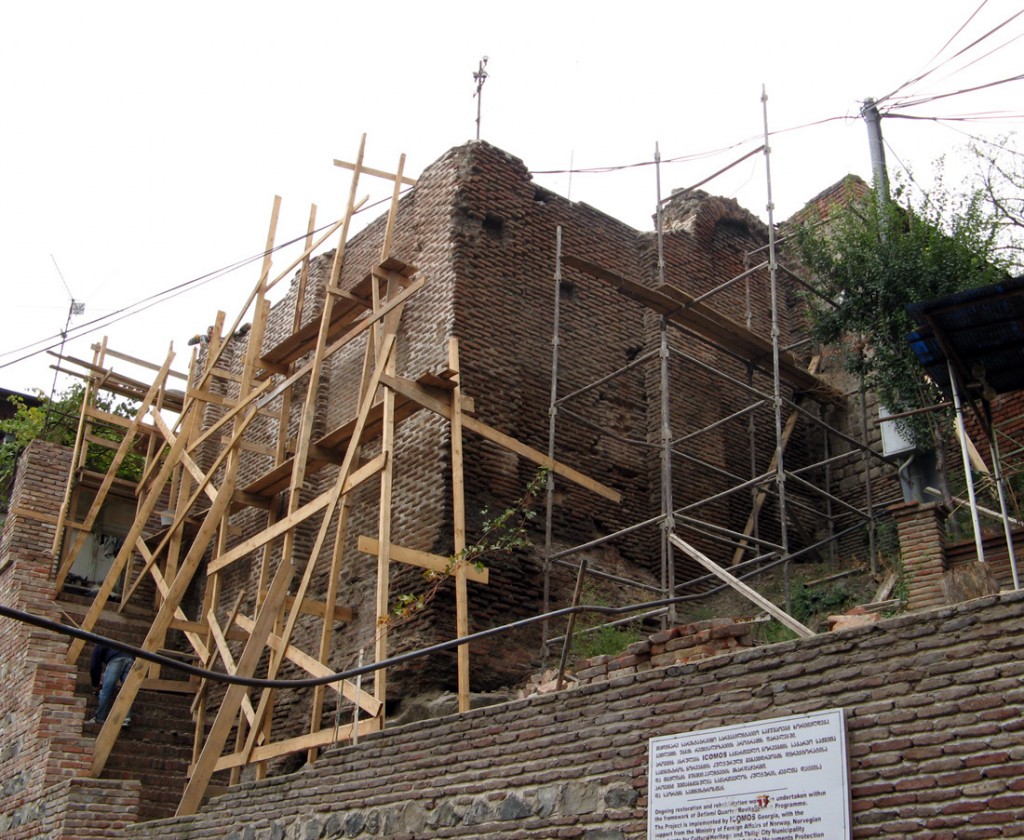 Remains of an “Atash-kade” (Zoroastrian fire-temple) undergoing repairs in Georgia. The cultural ties between Iran and Georgia stretch back for thousands of years (Picture courtesy of Dr. David Khoupenia with caption from Kaveh Farrokh’s lectures at the University of British Columbia’s Continuing Studies Division, Stanford University’s WAIS 2006 Critical World Problems Conference Presentations on July 30-31, 2006, University of Southern California and the University of Yerevan (Iranian Studies Department).
Remains of an “Atash-kade” (Zoroastrian fire-temple) undergoing repairs in Georgia. The cultural ties between Iran and Georgia stretch back for thousands of years (Picture courtesy of Dr. David Khoupenia with caption from Kaveh Farrokh’s lectures at the University of British Columbia’s Continuing Studies Division, Stanford University’s WAIS 2006 Critical World Problems Conference Presentations on July 30-31, 2006, University of Southern California and the University of Yerevan (Iranian Studies Department).
Sasanian rulers put the Christianity of the Georgians to a severe test. They promoted the teachings of Zoroaster, and by the middle of the 5th century Mazdaism had become a second official religion in eastern Georgia alongside Christianity. Yazdegerd II (438-57), convinced that a single religion would enhance the unity of his realm, issued a decree formally admonishing the peoples of the Caucasus to renounce Christianity and embrace Mazdaism and dispatched Zoroastrian magi to Kartli to take charge of conversion (Trever, pp. 203-5). The majority of Georgian nobles submitted, but their commitment to the new faith proved shallow. Efforts to convert the common people were even less successful, since Christianity appears to have struck deep roots among them.
In seeking to weaken Christianity, Persian rulers involved themselves in the internal affairs of the Christian churches in the Caucasus. They tried to take advantage of disputes among Christians by offering protection to the Monophysites, who were opposed to the Chalcedonian doctrines patronized by the Byzantine emperors, and they promoted unity among the Armenian, Albanian, and Georgian churches in order to extend their control more easily over them. Under Persian pressure the three churches adopted the Monophysite doctrines at Dvin in 506 (Berdzenishvili et al., I, p. 136), but when Persian vigilance slackened, the Chalcedonians rose again, and by the end of the 6th century Monophysitism in Georgia had all but disappeared.
Religious controversy was intertwined with political struggle in the 5th century. The leading champion of Georgian independence was King Vakhtang I (447-522; Toumanoff, 1990, p. 378), who was called Gorgasar “wolf-headed” (Gorgasa in Georgian) by the Persians, because of the shape of the helmet he wore. Married to a Persian princess, he guarded the northern passes through Kartli and participated in Persian campaigns against Byzantium between 455 and 458 and in India, probably in Pērōz’s wars against the Hephthalites in 474-76 (Dzhuansheriani, pp. 84-89). But loyalty had its limits. Vakhtang resented Persian encroachments on his independence and reinforced his position by supporting autocephalous status for the Georgian Church and by uniting western Georgia with Kartli (Muskhelishvili, p. 211). In 482 he led a general uprising against his suzerain and declared war on “Persian Christianity,” that is, Monophysitism. But he was defeated, and his country was ravaged by Persian punitive expeditions in 483 and 484 (Toumanoff, 1963, p. 365). After a short exile he made peace with the great king Balāš (q.v.) in 485 and returned to Kartli, but when Kavād I (488-96, 498-531) summoned him as a vassal to join in a new campaign against Byzantium, he refused. Their dispute may be related in part to Kavād’s efforts to force Mazdaism upon the Georgians. When Kavād attacked Kartli in 517-18, Vakhtang appealed to Justin I for help, but the Byzantines provided none, and he fled to Lazika, where he probably died in 522 (Frye, p. 152).
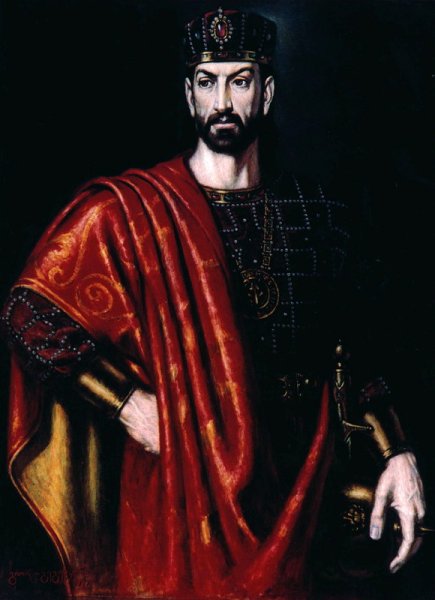 A Georgian portrayal of King Vakhtang I Gotgasar-Gorgasa (Source: Burusi).
A Georgian portrayal of King Vakhtang I Gotgasar-Gorgasa (Source: Burusi).
Byzantium and Persia continued their contest for supremacy in the Caucasus. War broke out in 526 and ended with the cession of Iberia to Persia in 532. But Ḵosrow I Anōšīravān (532-79) was eager to reach the Black Sea and in 542 moved through Iberia at the head of a large army toward Lazika and Colchis (Berdzenishvili et al., I, p. 120). The Byzantines countered by invading Persia and forcing Ḵosrow to make peace in 546. Once again it was merely a truce.
The Byzantine-Persian rivalry had baleful consequences for Iberia. In 580 Hormozd IV (579-90) abolished the monarchy after the death of King Bakur (Dzhuansheriani, p. 97), and Iberia became a Persian province. Hormozd at first had the support of the great nobles, but rather than receiving the enhanced privileges promised them, they were subjected to heavy taxation and a restrictive administration headed by a Persian-appointed governor (marzbān). When, therefore, the Byzantine emperor Maurice attacked Persia in 582 many Georgian nobles urged him to revive the kingdom of Iberia, but in 591 Maurice and Khusrau II Parvēz (590, 591-628) agreed to divide Iberia between them, with Tbilisi to be in Persian hands and Mtskheta, the old capital, to be under Byzantine control (Dzhuansheriani, pp. 98-99).
At the beginning of the 7th century the truce between Byzantium and Persia collapsed. Stepanoz I, Prince of Iberia (ca. 590-627), decided in 607 to join forces with Persia in order to reunite all the territories of Iberia, a goal he seems to have accomplished. But Emperor Heraclius’s offensive between 622 and 628 brought victory over the Georgians and Persians and ensured Byzantine predominance in western and eastern Georgia until the invasion of the Caucasus by the Arabs.
The Arabs reached Iberia about 645 and forced its prince, Stepanoz II (637-c. 650) to abandon his allegiance to Byzantium and recognize the caliph as his suzerain. Iberia thus became a tributary state, and an Arab amir was installed in Tbilisi about 653 (Balāḏorī, Fotūhá, pp. 201-2; Ṭabarī, I, p. 2674).
Between the Arabs’ consolidation of their position in eastern Georgia in the 730s and the emergence of the Safavid dynasty in Persia at the beginning of the 16th century the Georgian kingdom was revived, experienced a period of glory, and then declined in the face of powerful new enemies. At the beginning of the 9th century, Ashot I (813-30) of the new Bagratid dynasty (see BAGRATIDS), from his base in southwestern Georgia, took advantage of the weakness of the Byzantine emperor and the Arab caliph to establish himself as hereditary prince of Iberia. A successor, Bagrat III (1008-14), brought the various principalities together to form a united Georgian state, and David II “the Builder” (1089-1125), laid the foundations for Georgia’s golden age during the reign of Queen Tamara (1184-1213). Georgia’s decline began with the Mongol invasions of the 1220s, and, despite brief revivals, it proved inexorable. The rise of the Ottoman Turks and their capture of Constantinople in 1453 raised up a powerful new military threat to Georgia at a time when, at the end of the 15th century, the country had been fragmented into three kingdoms (Kartli, Kakheti, and Imereti) and the duchy of Samtskhe-Saatbago.
At the beginning of the 16th century Georgia once again lay in the precarious middle ground between two powerful enemies, the Ottoman Turks to the west and the Persian Safavids to the east. The two powers were themselves constantly at war (1514-55, 1578-90, 1602-18, 1623-39), with control of Georgia one of their objectives. Mainly under the leadership of the kings of Kartli the Georgians carried on a valiant, but unequal struggle to maintain their independence (for an overview of Georgia’s economic and political situation between Persia and the Ottoman Empire in the 16th–17th centuries, see Dumbadze, ed., pp. 85-186).
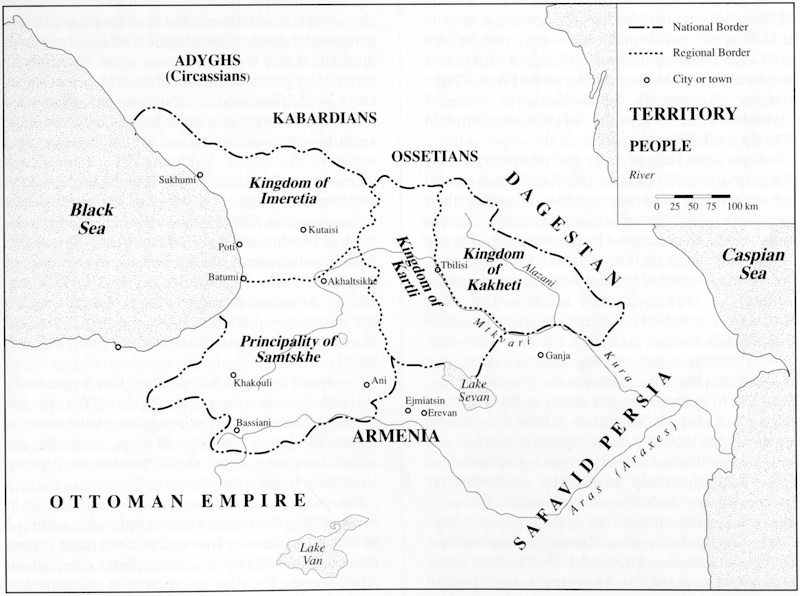 Map of the Caucasus region during the Safavid era(Source: Encyclopedia Iranica).
Map of the Caucasus region during the Safavid era(Source: Encyclopedia Iranica).
At first, the initiative lay with the Safavids. Shah Esmāʿīl I (907-30/1501-24), the founder of the dynasty, sent raiding expeditions into Georgia, notably in 1518, but he was too preoccupied with consolidating his hold on power at home to pursue more ambitious undertakings in the Caucasus (Możṭar, ed., pp. 109, 542-45, 555, 557; Ḥasan Rūmlū, ed. Navāʾī, pp. 218-19, 225; Brosset, II/1, p. 446). Shah Ṭahmāsb I (930-84/1524-76), who launched four campaigns against Georgia between 1540 and 1554, inaugurated the systematic extension of his dynasty’s control over Georgia. All four expeditions were costly for the Georgians. In the first, 947/1540-41, Persians captured Tbilisi and plundered it and the surrounding region. They repeated these practices during subsequent expeditions in 953/1546-47, 958/1551, and 961/1553-54. Much booty was taken, especially from Georgian churches, and Ṭahmāsb claimed as his rightful share the wives, daughters, and sons of the nobility, instead of the usual one-fifth of the treasure (Eskandar Beg, I, pp. 84-90, tr. Savory, I, pp. 140-44, 146; Ḥasan Rūmlū. ed. Navāʾī, pp. 383-85; Brosset, II/1, pp. 445-53, based on Eskandar Beg’s account with notes and commentary; on the importance of Eskandar Beg’s work for the history of Georgia, see Puturidze). The death, probably in 1558, of King Luarsab I (1534-57; Lovārṣāb in Eskandar Beg) brought a temporary end to the hostilities.
During these campaigns Ṭahmāsb brought to Persia large numbers of Georgians, whose subsequent role in the army and civil administration led to significant changes in the character of Safavid society. The new ethnic element became a “third force” which interposed itself between the two “founding elements,” the Persians and the Turkmen. Indeed, by the end of the 16th century the Georgians were threatening to replace the latter, the qezelbāš, as the military aristocracy of the realm.
The competition between the Ottomans and the Safavids for control of the Caucasus was temporarily interrupted by the Treaty of Amasya (962/1555, q.v.). In Georgia it established a rough balance between the two rivals, as Kartli, Kakheti, and eastern Samtskhe (Masq) fell into the Persian sphere of influence, and Imereti and western Samtskhe into the Ottoman.
Shah Ṭahmāsb used the opportunity to tighten Persian predominance in eastern Georgia by imposing Persian social and political institutions and by placing converts to Islam on the thrones of Kartli and Kakheti. One of these was David/Dāwūd Khan II (1569-78), whose reign marked the beginning of almost two and a half centuries of Persian political dominance over eastern Georgia, with only occasional interruptions, until the advent of the Russians at the end of the 18th century. To hasten the integration of eastern Georgia into his realm Ṭahmāsb used bilingual Georgian-Persian firmans to make Persian the official administrative language of the country (Tabatadze, pp. 262-63).
The Ottomans, eager to extend their control over Kartli and Kakheti, attacked Persian positions in eastern Georgia in 1578. Despite spirited resistance led by King Simon of Kartli (1557-69, 1578-99; Brosset, II/1, pp. 36-42), the Ottomans prevailed, and in 1590 the Persians recognized all of Georgia as an Ottoman possession (Uzunçarşili, pp. 57-63).
Shah ʿAbbās I (996-1038/1587-1629) was determined to restore Persian predominance in the Caucasus. Although he inflicted enormous devastation on the Georgian kingdoms and appointed and dismissed their rulers almost at will, he never succeeded fully in stamping out resistance to his rule. When he resumed war with the Ottoman Empire in 1602 he forced Giorgi X of Kartli (1599-1605) and Aleksandre II of Kakheti (1574-1605) to join the campaign. But resistance to ʿAbbās was fierce among the nobles. In 1605 they revolted and placed Teimuraz/Ṭahmūraṯ I (1605-63) on the throne, who for sixty years served as a rallying point for opposition to the Safavids. ʿAbbās acquiesced and confirmed Teimuraz as king in 1606. He also recognized Luarsab II (1605-14) as King of Kartli, but when Luarsab refused to become a Muslim and encouraged the nobles to reject a Muslim replacement for him, ʿAbbās exiled him to Isfahan and in 1622 had him strangled (Dumbadze, IV, p. 276).
ʿAbbās undertook another campaign in 1614 against Kartli and Kakheti, replacing their kings with Muslims. When nobles of Kakheti rose in revolt in 1615, his troops ravaged the country, a punishment from which it never fully recovered (Eskandar Beg, pp. 896-901, tr. Savory, II, pp. 1081-83; Brosset, II/1, pp. 484-87). Perhaps as many as 70,000 people were killed and over 100,00 deported to Persia. ʿAbbās appointed a loyalist, Simon II/Semāyūn Khan (1619-29), as wālī, or viceroy, but he kept a tight grip on Kakheti, administering it through an appointed governor (on the functions of the wālī and the role of other Persian officials appointed to supervise Georgian affairs in the 17th century, see Gabashvili, pp. 366-411). ʿAbbās regarded these arrangements as temporary and apparently planned to deal a drastic blow to the rebellious Georgians: the Kakhetians were to be wiped out or deported and their country settled by qezelbāš and other Turkmen tribes, while the nobles of Kartli were to be resettled in Persia (Berdzenishvili et al., I, p. 358).
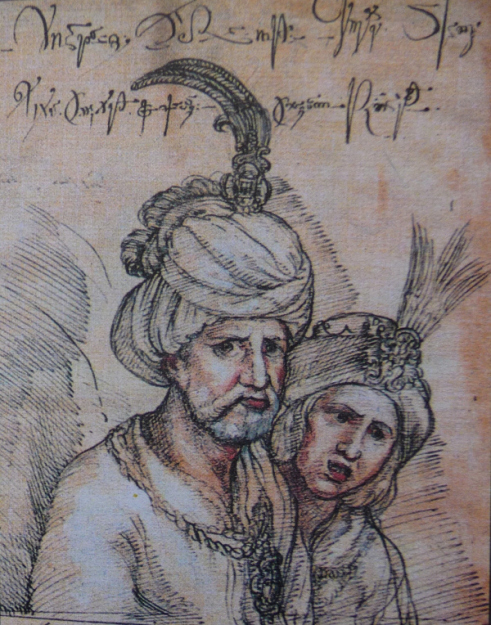 King Teimuraz/Ṭahmūraṯ I (r. 1603-63) of Georgia portrayed with his wife and Queen, Khorashan. Teimuraz was born in Iran and was fluent in Persian – he was highly appreciative of Persian poetry and literature. Teimuraz’s sons, his mother Queen Katevan (Georgian for Katayoun) and himself were to all to pass away in Iran (Picture courtesy of Dr. David Khoupenia with caption from Kaveh Farrokh’s lectures at the University of British Columbia’s Continuing Studies Division, Stanford University’s WAIS 2006 Critical World Problems Conference Presentations on July 30-31, 2006, University of Southern California and the University of Yerevan (Iranian Studies Department).
King Teimuraz/Ṭahmūraṯ I (r. 1603-63) of Georgia portrayed with his wife and Queen, Khorashan. Teimuraz was born in Iran and was fluent in Persian – he was highly appreciative of Persian poetry and literature. Teimuraz’s sons, his mother Queen Katevan (Georgian for Katayoun) and himself were to all to pass away in Iran (Picture courtesy of Dr. David Khoupenia with caption from Kaveh Farrokh’s lectures at the University of British Columbia’s Continuing Studies Division, Stanford University’s WAIS 2006 Critical World Problems Conference Presentations on July 30-31, 2006, University of Southern California and the University of Yerevan (Iranian Studies Department).
In subduing the two Georgian kingdoms, ʿAbbās had counted on a leading noble, Giorgi Saakadze (known to the Persians as Mūrāv Beg). A Muslim, he was admired in Persia for his military exploits and was regularly consulted on Georgian affairs (Eskandar Beg, pp. 1020-21, tr. Savory, pp. 1242-43). ʿAbbās had appointed him advisor to Simon II of Kartli and in 1620 entrusted both with the suppression of anti-Persian opposition. For reasons that are unclear Saakadze turned against ʿAbbās and led a rebellion of nobles in 1623. He invited the exiled Teimuraz/Ṭahmūraṯ to return home and proclaimed him king of Kartli and Kakheti. But in 1624, ʿAbbās won a decisive victory against the rebels on Marabda Field near Tbilisi (Eskandar Beg, pp. 1024-28, tr. Savory, pp. 1245-49; Dumbadze, IV, pp. 255-87). He also used the rivalry between Saakadze and Teimuraz to divide the Georgians and drive the former into exile in Istanbul, where in 1629 he was executed (Dumbadze, IV, pp. 1284-85).
ʿAbbās’s measures in Kartli and Kakheti represented a continuation of his predecessors’ efforts to integrate eastern Georgia fully into the Safavid empire. Besides war, he institutionalized the practice begun by Ṭahmāsb of employing Georgians as qūllar or ḡolāmān-e ḵāṣṣa-ye šarīfa in the Persian army and civil administration. They were obliged to become Muslims, but the majority of such conversions were entered into without conviction. After a period of training they were assigned either to the special regiments of the army or to a branch of the royal household administration. Estimates vary as to the size of the military forces composed of Georgian “slaves.” One source indicates that in 1588 ʿAbbās had formed his bodyguard from 12,000 of them taken into his service. Another source in 1608 puts the number of Georgian cavalry guards at 25,000 (Lang, 1952, p. 525). In any case, the Georgians were renowned throughout Persia as fierce warriors. Both Ṭahmāsb and ʿAbbās were pursuing a policy to strengthen the “third force” in Safavid society and thus diminish the power of the qezelbāš, whose loyalty had become suspect.
The contributions which the ḡolāmsmade to the Safavids were substantial. Many of ʿAbbās’s ḡolāms were the descendants of those Georgians who had been brought to Persia by Ṭahmāsb. Still other Georgians, nobles and princes among them, entered Persian service voluntarily, and a significant number achieved high office. Two outstanding examples were Allāhverdī Khan (d. 1022/1613), who rose to be governor of Fārs province and commander-in-chief of all Persian forces (sepahsālār-e Īrān), and his son, Emāmqolī Khan (qq.v.). Other Georgians became prefects (dārūḡa) of Isfahan. But the majority of the Georgians were settled in widely scattered parts of Persia and became cultivators of the soil. The most important of these Georgian colonies was in Farīdan (q.v.) in Isfahan province, where their descendants still speak Georgian and retain their Christian faith (Oberling, pp. 128-33; Sharashenidze).
 Preliminary photo of the golden Winged-Lion of Meskheti (Copyright of Georgian Academy of Sciences and Manuscripts, Tbilisi, Georgia). Georgian Iranologists and the Georgian Academy of Sciences have determined that the origin of this lion is from Iran. The reports of the study were published by Kaveh Farrokh in “Scientific Paradigms: Studies in Honour of Professor Natela Vachnadze. St. Andrew the First-Called Georgian University of the Patriarchy of Georgia in 2009” (Picture courtesy of Dr. David Khoupenia with caption from Kaveh Farrokh’s lectures at the University of British Columbia’s Continuing Studies Division, Stanford University’s WAIS 2006 Critical World Problems Conference Presentations on July 30-31, 2006, University of Southern California and the University of Yerevan (Iranian Studies Department).
Preliminary photo of the golden Winged-Lion of Meskheti (Copyright of Georgian Academy of Sciences and Manuscripts, Tbilisi, Georgia). Georgian Iranologists and the Georgian Academy of Sciences have determined that the origin of this lion is from Iran. The reports of the study were published by Kaveh Farrokh in “Scientific Paradigms: Studies in Honour of Professor Natela Vachnadze. St. Andrew the First-Called Georgian University of the Patriarchy of Georgia in 2009” (Picture courtesy of Dr. David Khoupenia with caption from Kaveh Farrokh’s lectures at the University of British Columbia’s Continuing Studies Division, Stanford University’s WAIS 2006 Critical World Problems Conference Presentations on July 30-31, 2006, University of Southern California and the University of Yerevan (Iranian Studies Department).
During the remaining century of Safavid predominance in Georgia after the death of ʿAbbās in 1629 Persian influence was unprecedented. The kingdom of Kartli was transformed into a province of Persia and regularly paid tribute and sent gifts (pīškeš) to the shah in the form of boys and girls, horses, and wines (Berdzenishvili, ed., 1973, pp. 252-54). The Georgian economy was also closely linked to that of Persia, and Georgian literature was enriched by translations of Persian classics and adaptations of Persian genres.
Nonetheless, in contrast to the calamities of Shah ʿAbbās’s reign, eastern Georgia experienced a period of relative peace and prosperity under an enlightened and able viceroy, Ḵosrow Mīrzā, the son of Dāwūd Khan and a Muslim. As a reward for aiding Sām Mīrzā gain the throne as Shah Ṣafī (1038-52/1629-42) the shah granted him the title Rostam Khan and in 1632 appointed him wālī of Kartli, a post he held until 1658 (Bagrationi, pp. 63-68). His willingness to cooperate with his suzerains won for Kartli a large measure of autonomy, but Kakheti, the center of unyielding resistance to the Safavids, was brought directly under Persian rule.
Kakheti knew little of peace and prosperity during this period, as nobles and the populace rallied around the exiled Teimuraz in the hope of ending their subjection to Muslims. Teimuraz himself was intent upon uniting all of eastern Georgia under his rule and sought help from the Ottomans and the Russians. But when he contested Rostam Khan’s administration in Kartli in 1634, neither of his presumed allies moved to support him. At the behest of Shah ʿAbbās II (1642-66) Rostam invaded Kakheti in 1648 and, driving Teimuraz into exile again, was named ruler of Kakheti (1648-56; Berdzenishvili et al., I,pp. 368-69). In order to end resistance in Kakheti once and for all, the shah revived ʿAbbās I’s plan to populate the country with Turkmen nomads, a measure that incited a general uprising of nobles in 1659. Although they halted the settlement of Turkmens, they failed to shake Persian control of their country (Berdzenishvili et al., I, pp. 369-72).
Georgian nobles now grudgingly recognized the need for an accommodation with the Persians. Even Teimuraz concluded that the prospects for Georgian independence were nil and submitted to Persia. But when his grandson Erekle/Ereglī Khan rejected Teimuraz’s understanding with the shah, both men were imprisoned. Teimuraz died in captivity in 1663.
The Persian-appointed kings of Kartli never completely abandoned the idea of independence. Vakhtang V (1659-75), Šāhnavāz II to the Persians, tried to reestablish a united kingdom in eastern Georgia by placing his son, Archil II, on the throne of Kakheti (Brosset, II/1, pp. 74-78; Asatiani, pp. 115-26). Although Archil converted to Islam and assumed the title Šāhnaẓar Khan (1664-75), factions at the Persian court thwarted Vakhtang’s master plan (Bagrationi, p. 159).
Giorgi XI (1678-88) tried to achieve the unity his father, Vakhtang, had sought, but the shah discovered his plans and forced him into exile (for Georgian-Iranian relations between 1675 and 1725, see Tabagua, pp. 12-41). But Giorgi/Gorgīn Khan, too, eventually reconciled himself to Persian suzerainty and in 1696 agreed to terms with the new shah, Solṭān Ḥosayn (1105-35/1694-1722). It was the beginning of an illustrious but, ultimately, tragic career in the service of the Safavids. The shah entrusted him with restoring order along the eastern frontiers of the empire. As beglarbegī of Kermān, Giorgi, aided by his brother Levan, by 1700 had reestablished the shah’s fiat in the region. As a reward the shah made Levan dīvānbegī (q.v.) of Persia and his son, Kaikhosro/Ḵosrow Khan, dārūḡa of Isfahan. The shah appointed Giorgi commander-in-chief (sepahsālār) of his armies and dispatched him to the east once again, this time to relieve the garrison at Qandahār, which was under siege by Afghan rebels. The shah also designated him wālī of Kartli, but, while he was in the field, he entrusted the administration of the country to a nephew, the future Vakhtang VI. Giorgi was victorious at Qandahār in 1704, but the leaders of the anti-Georgian faction at the shah’s court had him assassinated in 1709. A punitive expedition to the Afghan border led by Kaikhosro in 1711 ended disastrously with his death and the destruction of nearly his entire force of 30,000 (Lang, 1952, pp. 530-34; for a contemporary account of the Georgian-led campaigns between 1700 and 1711, see the chronicle of Sekhnia Chkheidze in Brosset, II/2, pp. 16-31).
For much of the 18th century Persia generally maintained its position in Georgian affairs, but the viceroys asserted their independence whenever the opportunity arose. They looked for support to Russia, which now supplanted the Ottomans as Persia’s chief rival in the Caucasus.
Vakhtang VI, wālī of Kartli (1711-14, 1719-23), at first opposed Persian predominance and was forced to give up his throne. But in 1716, convinced that no foreign aid would be forthcoming, he accepted Islam. After serving the shah as sepahsālār of Persia and beglarbegī of Azerbaijan, he became wālī of Kartli again in 1719. But his true allegiance was to Georgia, and he made no secret of his pro-Russian and pro-Christian sentiments to Russian envoys in Persia (Butkov, pp. 16, 51). When Persia was attacked by the Afghans in 1722 and the Ottomans in 1723, he sided with the Russians (Paichadze, 1970, pp. 35-59). He hoped that Peter the Great would not only seek gains for Russia, but would also protect Georgia from both Persians and Turks (Paichadze, 1965, pp. 26-35). But the tsar cut short his Caucasus campaign, and Vakhtang had to flee to Russia, where he died in 1737.
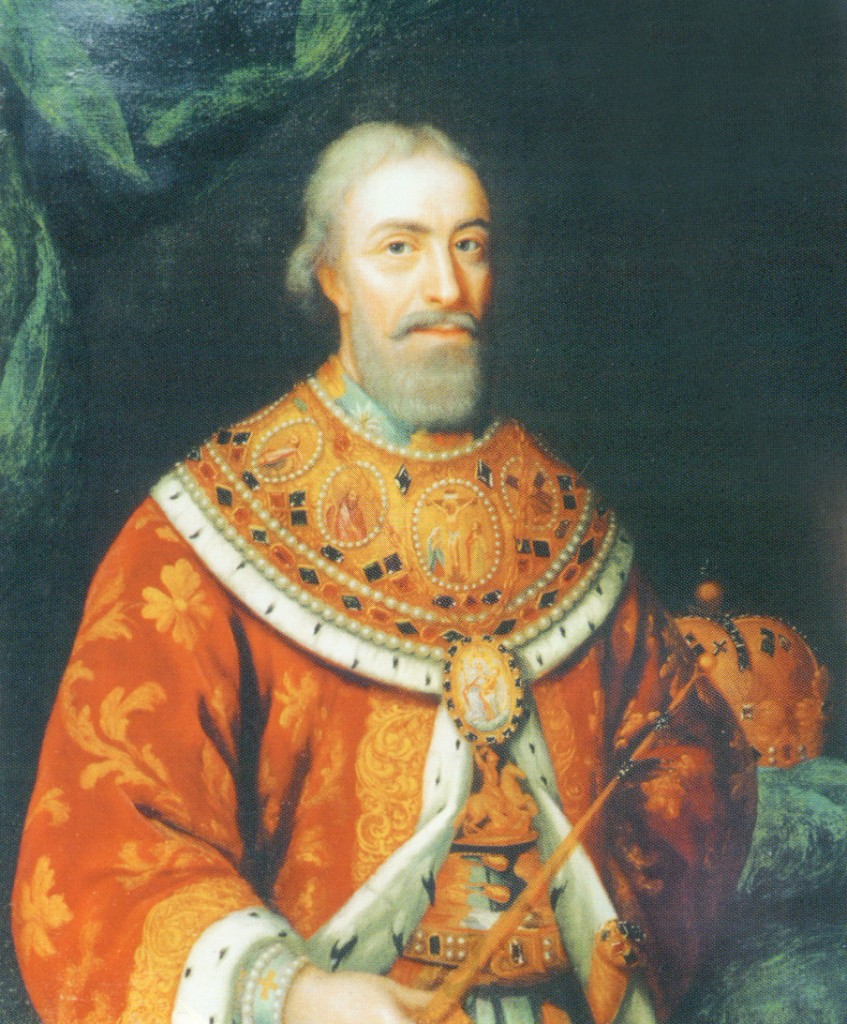 King Vakhtang VI (r. 1711-14, 1719-23) of Georgia. Despite the “European appearance” with his attire, Vakhtang VI did much to foster the literary contacts between Persia and Georgia (Picture courtesy of Dr. David Khoupenia with caption from Kaveh Farrokh’s lectures at the University of British Columbia’s Continuing Studies Division, Stanford University’s WAIS 2006 Critical World Problems Conference Presentations on July 30-31, 2006, University of Southern California and the University of Yerevan (Iranian Studies Department).
King Vakhtang VI (r. 1711-14, 1719-23) of Georgia. Despite the “European appearance” with his attire, Vakhtang VI did much to foster the literary contacts between Persia and Georgia (Picture courtesy of Dr. David Khoupenia with caption from Kaveh Farrokh’s lectures at the University of British Columbia’s Continuing Studies Division, Stanford University’s WAIS 2006 Critical World Problems Conference Presentations on July 30-31, 2006, University of Southern California and the University of Yerevan (Iranian Studies Department).
Under the vigorous Nāder Shah Afšār (1148-60/1736-47), Persia reasserted itself in the Caucasus. In 1734 and 1735 he drove the Ottomans out of eastern Georgia, confirmed Teimuraz II (1729-44) as wālī of Kakheti, and appointed a Persian as governor of Kartli. His forces pillaged the country and deported thousands of villagers to Persia (Brossert, II/2, pp. 49-50). When the Georgian nobles revolted, Teimuraz and his son Erekle, who had fought with Nāder Shah’s armies in India in 1737-40, aided the Persians in defeating the rebels. For services rendered, Nāder Shah awarded Kartli to Teimuraz (1744-62) and Kakheti to his son, Erekle II (1744-62; Bagrationi, pp. 177-82). Yet, Nāder Shah continued his despotic ways, relentlessly draining both countries of their resources (Brosset, II/2, pp. 114-19).
Nāder Shah’s assassination in 1747 promised a measure of relief. The new ruler, ʿĀdel Shah (1160-61 /1747-48, q.v.), who had married one of Teimuraz’s daughters, sought Georgian help in consolidating his rule over all of Persia (Brosset, pp. 118-25). Both Teimuraz and Erekle used the opportunity to assert their independence. When Teimuraz died in 1762 Erekle succeeded him, thus uniting eastern Georgia as a single state for the first time in nearly three centuries.
Under Erekle II (1762-98) the independence of Kartli-Kakheti remained precarious, and he reluctantly decided to seek Russian protection. His policy coincided with Catherine II’s renewed interest in Georgia, and in 1783 the two monarchs signed the Treaty of Georgievsk, which made Kartli-Kakheti a Russian protectorate (Tsagareli, pp. iii-x, 32-36; Paichadze, 1983, pp. 91-137). It also marked the beginning of the end of Persia’s pretensions to political dominance over Georgia.
The founder of the Qajar dynasty, Āḡā Moḥammad Khan (1193-1212/1779-97, q.v.) was determined to recover those provinces that had once formed part of the Safavid empire. Georgia was the special object of his ambitions. Erekle (Ereglī Khan) refused to become a mere wālī of Kartli-Kakheti and reaffirmed his attachment to Russia. Āḡā Moḥammad responded by attacking the country, capturing Tbilisi in September 1795 and deporting some 15,000 of its inhabitants to Persia as slaves (Hedāyat, Rawżat al-ṣafā IX, pp. 269-71; Tsagareli, II/2, pp. 107-24; Hambly, pp. 126-30). His assassination in 1797 ended plans for a second expedition into Georgia.
Fatḥ-ʿAlī Shah (1212-50/1797-1834), Āḡā Muḥammad’s successor, pursued a similar policy toward Georgia. In 1798 he demanded the unconditional submission of Erekle’s son and successor, Giorgi XII (1798-1800; Tsagareli, II/2, pp. 181-82). Giorgi refused, and Russia’s firm support caused Persian armies to remain in place (Dubrovina, pp. 116-21).
The end of Georgian independence, nonetheless, was at hand. When Giorgi died in December 1800, Tsar Paul took advantage of the interregnum to proclaim the incorporation of Kartli and Kakheti into the Russian Empire in January 1801. War with Persia, which broke out in 1804, ended in 1813 with the Treaty of Golestān. Under its terms Persia gave up all claims to Kartli and Kakheti in favor of Russia, thereby effectively ending her centuries-long involvement in Georgian political affairs.
Although Russia and Persia were at peace, Fatḥ-ʿAlī Shah had not given up hope of reclaiming Georgia. War between the two countries broke out again in 1826, and Russia’s success on the battlefield and the Treaty of Torkamānčāy in 1828 confirmed her control of Georgia (Shengelia, pp. 55-72). The treaty also set the tone of Russo-Iranian relations down to World War I and made manifest Persia’s inability to challenge Russia’s supremacy in Georgia and the Caucasus.
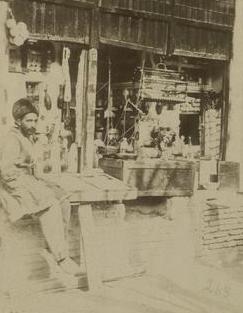 A unique photo of a 19th century Persian pharmacy and apothecary in old Tbilisi, Georgia. Despite the imperial Russian conquests of the early 19th century and subsequent Czarist (and later Communist) efforts to “de-Persianize” the Caucasus, modern-day Georgians do acknowledge an Iranian legacy in their country (see Nowruz in Georgia and the Georgian Legacy in Iran) (Picture courtesy of Dr. David Khoupenia).
A unique photo of a 19th century Persian pharmacy and apothecary in old Tbilisi, Georgia. Despite the imperial Russian conquests of the early 19th century and subsequent Czarist (and later Communist) efforts to “de-Persianize” the Caucasus, modern-day Georgians do acknowledge an Iranian legacy in their country (see Nowruz in Georgia and the Georgian Legacy in Iran) (Picture courtesy of Dr. David Khoupenia).
Bibliography
W. E. D. Allen, A History of the Georgian People, London, 1932.
N. Asatiani, “Kakheti Archil II-is mepobis dros (1664-1675 ts. ts.)” (Kakheti during the reign of Archil II), in Sakartvelo da Agmosavleti (Georgia and the East), Tbilisi, 1984.
J.-L. Bacqué-Grammont and C. Adle, “Notes sur les Safavides et la Géorgie, 1521-1524,” Stud. Ir. 9/2, 1980, pp. 211-31.
Vakhushti Bagrationi, Istoriya tsarstva gruzinskogo (History of the Georgian kingdom), ed. N. T. Nakashidze, Tbilisi, 1976.
N. Berdzenishvili, I. Dzhavakhishvili, and S. Dzhanishia, Istoriya Gruzii (History of Georgia) I, Tbilisi, 1946.
Idem, ed., Sakartvelos istoriis sakitkhebi (Questions of Georgian history) VI, Tbilisi, 1973.
M. Brosset, Histoire de la Géorgie, 2 vols., St. Petersburg, 1849-57.
P. P. Bushev, Istoriya posolʿstv i diplomaticheskikh otnoshenii russkogo i iranskogo gosudarstv v 1613-1621 (History of embassies and diplomatic relations of the Russian and Persian states, 1613-1621), Moscow, 1987.
P. G. Butkov, Materialy dlia novoi istorii Kavkaza, s 1722 po 1803 god (Materials for a modern history of the Caucasus, from 1722 to 1803) II, St. Petersburg, 1869.
N. Dubrovina, Georgii XII, poslednii tsarʿ Gruzii i prisoedinenie eia k Rossii (Giorgi XII, the last king of Georgia, and its annexation to Russia), St. Petersburg, 1897.
M. Dumbadze, ed., Sakartvelos istoriis narkvevebi (Studies on the history of Georgia) IV, Tbilisi, 1973. Dzh. Dzhuansheriani, Zhiznʿ Vakhtanga Gorgasala, ed. G. V. Tsulaia, Tbilisi, 1986.
R. N. Frye, “The Political History of Iran under the Sasanians” in Camb. Hist. Iran III, pp. 116-80.
V. Gabashvili, Kartuli peodaluri tskhobileba XVI-XVII saukuneebshi (The Georgian feudal regime in the 16th and 17th centuries), Tbilisi, 1958.
G. R. G. Hambly, “Āghā Muḥammad Khān and the Establishment of the Qājār Dynasty,” in Camb. Hist. Iran VII, pp. 104-43.
S. Kaukhchishvili, ed., Kartlis tskhovreba (The chronicles of Georgia), 2 vols., Tbilisi, 1955-59.
T. Kaukhchishvili, ed., Herodotes tsnobebi Sakartvelos shesakheb (Information concerning Georgia in Herodotus), Tbilisi, 1960.
D. M. Lang, “Georgia and the Fall of the Safavī Dynasty,” BSO(A)S 14, 1952, pp. 523-39.
Idem, The Last Years of the Georgian Monarchy, 1658-1832, New York, 1957.
Idem, The Georgians, New York, 1966, pp. 57, 75-76.
Idem, “Iran, Armenia, and Georgia,” in Camb. Hist. Iran III/1, pp. 505-36.
V. G. Lukonin, “Zavoevaniya Sasanidov na vostoke i problema kushanskoi absoliutnoi khronologii” (The conquests of the Sasanians in the east and the problem of the precise Kushan chronology), Vestnik drevnei istorii, 1969.
G. Melikishvili, K istorii drevnei Gruzii (On the history of ancient Georgia), Tbilisi, 1959.
Idem, ed., Sakartvelos istoriis narkvevebi (Studies on the history of Georgia) I, Tbilisi, 1970.
T. Mikeladze, ed., Ksenopontis ʿAnabasisiʿ. Tsnobebi kartveli tomebis shesakheb (Xenophon’s Anabasis. Information concerning Georgian tribes), Tbilisi, 1967.
D. L. Muskhelishvili, Osnovnye voprosy istoricheskoi geografii Gruzii (The fundamental questions of the historical geography of Georgia), Tbilisi, 1977.
A. D. Możtar, ed., Jahāngošā-ye Ḵāqān, Islamabad, 1350 Š./1971.
P. Oberling, “Georgians and Circassians in Iran,” Studia Caucasica 1, 1963, pp. 128-33.
G. G. Paichadze, Russko-gruzinskie otnosheniya v 1725-1735 gg. (Russo-Georgian relations, 1725-1735), Tbilisi, 1965.
Idem, Russko-gruzinskie otnosheniia vpervoi polovine XVIII veka (Russo-Georgian relations in the first half of the 18th century), Tbilisi, 1970.
Idem, Georgievskii traktat (The Treaty of of Georgiev), Tbilisi, 1983.
V. Puturidze, ed., Iskander Munshis tsnobebi Sakartvelos shesakheb (Information about Georgia in Iskander Munshi’s work), Tbilisi, 1969.
Z. Sharashenidze, Akhali masalebi pereidneli kartvelebis shesakheb (New material concerning the Georgians of Fereydan), Tbilisi, 1969.
L. Shengelia, Amierkavkasia da iran-rusetis urtiertoba XIX saukunis pirvel mesamedshi (Transcaucasia and Iranian-Russian relations in the first third of the 19th century), Tbilisi, 1979.
R. G. Suny, The Making of the Georgian Nation, 2nd ed., Bloomington, 1994.
I. Tabagua, Masalebi XVIII saukunis pirveli meotkhedis Sakartvelos istoriisatvis (Materials for the history of Georgia in the first quarter of the 18th century), Tbilisi, 1982.
G. Tabatadze, “Voprosy istochnikovedcheskoi kharakteristiki dvuiazycnykh gruzino-persidskikh istoricheskikh dokumentov” (Questions concerning the character of bilingual Georgian-Persian historical documents as sources), in R. K. Kiknadze, ed., Istochnikovedcheskie razyskaniya 1985 (Researches in history), Tbilisi, 1988.
E. W. Thomson, Rewriting Caucasian History: The Medieval ArmenianAdaptation of the Georgian Chronicles, Oxford, 1996.
C. Toumanoff, “Christian Caucasia between Byzantium and Iran. New Light from Old Sources,” Traditio 10, 1954, pp. 109-89.
Idem, Studies in Christian Caucasian History, Washington, D. C., 1963.
Idem, Les dynasties de la Caucasie chrétienne de l’Antiquité jusqu’au XIXe siècle, Rome, 1990.
K. Trever, Ocherki po istorii i kulʿture kavkazskoi Albanii (Studies on the history and culture of Caucasian Albania), Moscow, 1959.
A. A. Tsagareli, Gramoty i drugie istoricheskie dokumenty XVIII stoletiya, otnosyashchietsia do Gruzii (Official documents and other historical documents of the 18th century relating to Georgia) II/2, St. Petersburg, 1902.
I. H. Uzunçarşili, Osmanli tarihi III/1, 2nd ed., Ankara, 1973.



